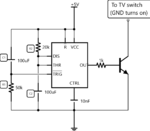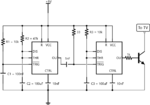poolshark021
Newbie level 4

I'm trying to design a circuit to automatically turn on a tv when it is plugged in. My tv power button won't work for the first 4 seconds after it's plugged in. I need a circuit that waits 5 seconds after being powered on and then provides a 1-2 second pulse to ground to simulate the power button press and then never again (a second pulse would turn it off). I'm trying to use a 555 timer in monostable mode but I'm unsure about the delay to start the trigger. Here is what I've got so far. (The program I'm using doesn't show GND pin on 555 for some reason)

My question is that the 555 datasheet I'm looking at says the trigger pin has to go back HI before the threshold voltage is reached in order for the output to be turned off. The way I'm reading this the output would never turn off since the trigger pin would always stay low once C1 was charged? Do I need to drain C1 during the output?

My question is that the 555 datasheet I'm looking at says the trigger pin has to go back HI before the threshold voltage is reached in order for the output to be turned off. The way I'm reading this the output would never turn off since the trigger pin would always stay low once C1 was charged? Do I need to drain C1 during the output?



